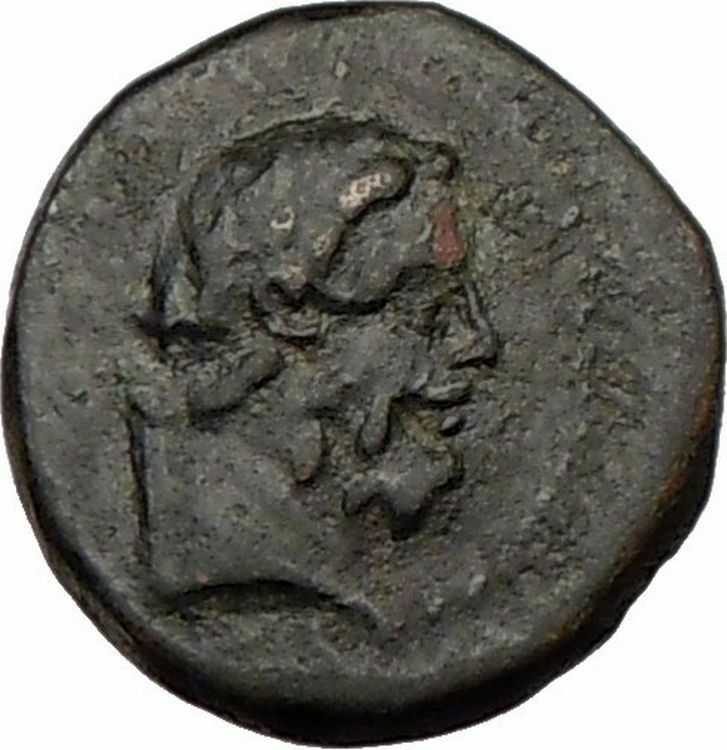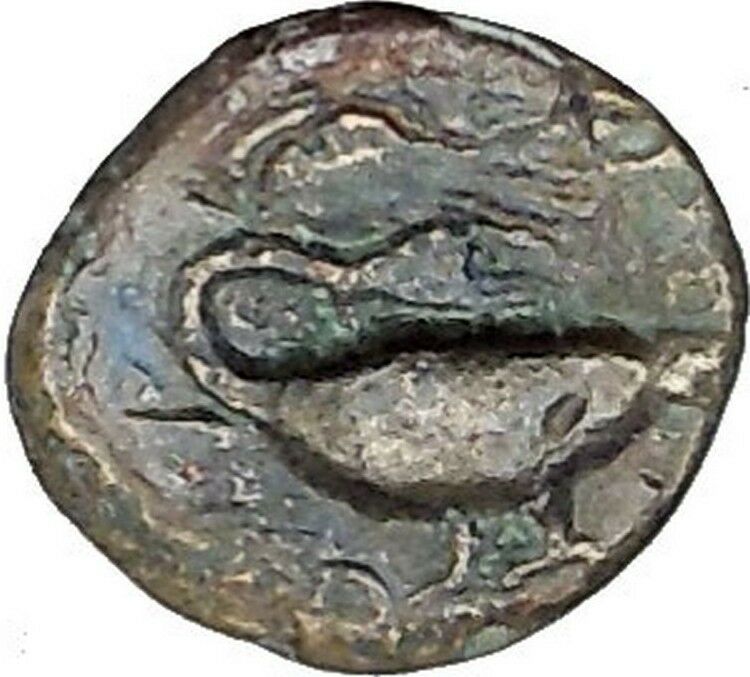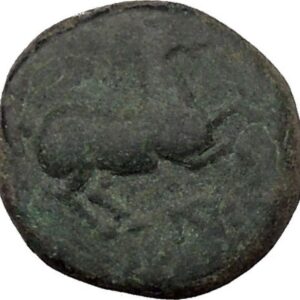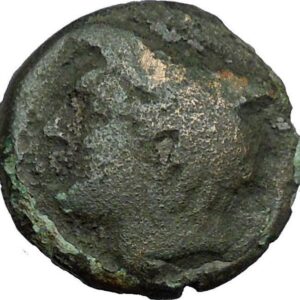|
Greek city of
Mytilene, chief city of the Island of
Lesbos
Bronze 10mm (0.72 grams) Struck circa 440-350 B.C.
Reference: Sear 4270 var.; HGC 6, 1057 var.; BMC Troas, p. 184, no.5 var.
Laureate head of Apollo right.
MYTI,
Bull’s head right.
Lesbos was the largest of the islands off the coast of western Asia Minor,
Lesbos lay at the entrance to the gulf of Adramytteion. It was a great cultural
center, and its mild climate and fertile soil supported no less than five
cities, the most important of which was Mytilene. The chief city of Lesbos,
Mytilene was situated in the south-east of the island, opposite the mainland.
There can be little doubt that Mytilene was the mint of the important electrum
coinage of Lesbos in the 5th and 4th centuries.
You are bidding on the exact item pictured,
provided with a Certificate of Authenticity and Lifetime Guarantee of
Authenticity.

In
Greek
and
Roman mythology
,
Apollo,
is one of the most important and diverse of the
Olympian deities
. The ideal of the
kouros
(a beardless youth), Apollo has been
variously recognized as a god of light and the sun; truth and prophecy;
archery
; medicine and healing; music, poetry,
and the arts; and more. Apollo is the son of
Zeus and Leto
, and has a
twin
sister, the chaste huntress
Artemis
. Apollo is known in Greek-influenced
Etruscan mythology
as Apulu. Apollo was
worshiped in both
ancient Greek
and
Roman religion
, as well as in the modern
Greco
–Roman
Neopaganism
.
As the patron of Delphi
(Pythian Apollo), Apollo was an
oracular
god — the prophetic deity of the
Delphic Oracle
. Medicine and healing were
associated with Apollo, whether through the god himself or mediated through his
son Asclepius
, yet Apollo was also seen as a god
who could bring ill-health and deadly
plague
as well as one who had the ability to
cure. Amongst the god’s custodial charges, Apollo became associated with
dominion over
colonists
, and as the patron defender of herds
and flocks. As the leader of the
Muses (Apollon Musagetes) and director of their choir, Apollo
functioned as the patron god of music and
poetry
.
Hermes
created the
lyre for him, and the instrument became a common
attribute
of Apollo. Hymns sung to Apollo were
called paeans
.
In Hellenistic times, especially during the third century BCE, as Apollo
Helios he became identified among Greeks with
Helios
,
god of the sun
, and his sister Artemis
similarly equated with
Selene
,
goddess of the moon
. In Latin texts, on the
other hand, Joseph Fontenrose declared himself unable to find any conflation of
Apollo with
Sol
among the
Augustan poets
of the first century, not even
in the conjurations of
Aeneas
and
Latinus
in
Aeneid
XII (161–215). Apollo and Helios/Sol
remained separate beings in literary and mythological texts until the third
century CE.
Mytilene (Greek:
Μυτιλήνη) is the
capital
city
of
Lesbos
, a Greek island
in the
Aegean Sea
,
and capital of
Lesbos Prefecture
and the Northern Aegean region. It is built on the
southeast edge of the island. Mytilene, whose name is pre-Greek, is also the
seat of a metropolitan
bishop
of the
Orthodox church
.
As an ancient city, lying off the east coast, Mytilene was initially confined
to an island that later was joined to
Lesbos
,
creating a north and south harbour.[
neededcitation] Mytilene contested successfully with
Methymna
in the north of the island for the leadership of the island in the
seventh century BC and became the centre of the island’s prosperous hinterland.[
neededcitation] Her most famous citizens were the poets
Sappho
and
Alcaeus
and the statesman
Pittacus
(one of the Seven Sages of ancient Greece). The city was famed for
its great output of
electrum
coins struck from the late 6th through mid 4th centuries BC.[2]
Mytilene revolted against Athens in 428 BC but was overcome by an Athenian
expeditionary force. The Athenian public assembly voted to massacre all the men
of the city and to sell the women and children into slavery but
changed its mind
the next day. A fast trireme sailed the 186 nautical miles
in less than a day and brought the decision to cancel the massacre.
Aristotle
lived on Mytilene for two years, 337-335 BC, with his friend and successor,
Theophrastus
after becoming the tutor to
Alexander
, son of King Philip II of Macedon.[3][4]
The Romans, among whom was a young
Julius Caesar
, successfully besieged Mytilene in 80 B.C. Although Mytilene
supported the losing side in most of the great wars of the first century BC her
statesmen succeeded in convincing Rome of her support of the new ruler of the
Mediterranean and the city flourished in Roman times.
In AD 56
Paul the Apostle
stopped there on the return trip of his third missionary
journey(
20:14Acts).
Sappho (pronounced
/ˈsæfoʊ/
in English;
Attic Greek
Σαπφώ
/sapːʰɔː/
,
Aeolic Greek
Ψάπφω
[psapːʰɔː]
) was an
Ancient Greek
poet, born on the island of
Lesbos
. Later Greeks included her in the list
of
nine lyric poets
. Her birth was sometime
between 630 and 612 BC, and it is said that she died around 570 BC, but little
is known for certain about her life. The bulk of her poetry, which was
well-known and greatly admired throughout antiquity, has been lost, but her
immense reputation has endured through surviving fragments.

//
Life
The only contemporary source which refers to Sappho’s life is her own
body of poetry, and scholars are skeptical of biographical readings of it. Later
biographical traditions, from which all more detailed accounts derive, have also
been cast into doubt.[1]
Chronology
Strabo
says that Sappho was the contemporary of
Alcaeus of Mytilene
(born ca. 620 BC) and
Pittacus
(ca. 645 – 570 BC) and according to
Athenaeus
she was the contemporary of
Alyattes
of Lydia (ca. 610 – 560 BC). The
Suda
, a 10th century
Byzantine
encyclopædia, dates her to the 42nd
Olympiad (612/608 BC), meaning either that she was born then or that this was
her
floruit
. The versions of
Eusebius
state that she was famous by the first
or second year of the 45th or 46th Olympiad (between 600 and 594 BC). Taken
together, these references make it likely that she was born ca. 620 BC, or a
little earlier.
Judging from the
Parian Marble
she was exiled from Lesbos to
Sicily
sometime between 604 and 594 BC. If
fragment 98 of her poetry is accepted as biographical evidence and as a
reference to her daughter (see below), it may indicate that she had already had
a daughter by the time she was exiled. If fragment 58 is accepted as
autobiographical it indicates that she lived into old age. If her connection to
Rhodopis (see below) is accepted as historical it indicates that she lived into
the mid-6th century BC.[2][3]
Family
An
Oxyrhynchus
papyrus from around AD 200[4]
and the Suda agree that Sappho had a mother called Cleïs and a daughter by the
same name. A papyrus line reads “She [Sappho] had a daughter Cleis named after
her mother.” (Duban 1983, 121) Two preserved fragments of Sappho’s poetry refer
to a Cleïs. In fragment 98, Sappho addresses Cleïs, saying that she has no way
of obtaining a decorated headband for her. Fragment 132 reads in full: “I have a
beautiful child [pais] who looks like golden flowers, my darling Cleis,
for whom I would not (take) all Lydia or lovely…”[5]
These fragments have often been interpreted as referring to Sappho’s daughter or
as confirming that Sappho had a daughter with this name. But even if a
biographic reading of the verses is accepted, this is not certain. Cleïs is
referred to in fragment 132 with the Greek word pais, which can as easily
indicate a
slave
or any young person as an offspring. It
is possible that these verses or others like them were misunderstood by ancient
writers, leading to the biographical tradition which has come down to us.[6]
Fragment 102 has its speaker address a “sweet mother”, sometimes taken as an
indication that Sappho began to write poetry while her mother was still alive.[7]
The name of Sappho’s father is widely given as Scamandronymus,[8]
he is not referred to in any of the surviving fragments. In his
Heroides
, Ovid has Sappho lament that, “Six
birthdays of mine had passed when the bones of my parent, gathered from the
pyre, drank before their time my tears.” Ovid may have based this on a poem by
Sappho no longer extant.[9]
Sappho was reported to have three brothers; Erigyius (or Eurygius), Larichus
and Charaxus. The Oxyrhynchus papyrus says that Charaxus was the eldest but that
Sappho was more fond of the young Larichus.[10]
According to Athenaeus, Sappho often praised Larichus for pouring wine in the
town hall of Mytilene, an office held by boys of the best families.[11]
This indication that Sappho was born into an aristocratic family is consistent
with the sometimes rarefied environments which her verses record.
A story given by
Herodotus
and later by Strabo, Athenaeus,
Ovid
and the Suda, tells of a relation between
Charaxus and the Egyptian courtesan
Rhodopis
. Herodotus, the oldest source of the
story, reports that Charaxus ransomed Rhodopis for a large sum and that after he
returned to Mitylene, Sappho scolded him in verse.[12]
Strabo, writing some 400 years later, adds that Charaxus was trading with
Lesbian wine and that Sappho called Rhodopis Doricha. Athenaeus, another
200 years later, calls the courtesan Doricha and maintains that Herodotus had
her confused with Rhodopis, another woman altogether.[9]
He also cites an epigram by
Posidippus
(3rd c. BC) which refers to Doricha
and Sappho. Based on this story, scholars have speculated that references to a
Doricha may have been found in Sappho’s poems. None of the extant fragments have
this name in full but fragments 7 and 15 are often restored to include it.[13]
Joel Lidov has criticized this restoration, arguing that the Doricha story is
not helpful in restoring any fragment by Sappho and that its origins lie in the
work of
Cratinus
or another of Herodotus’ comic
contemporaries.[14]
The Suda
is alone in claiming that Sappho was
married to a “very wealthy man called Cercylas, who traded from Andros”[15]
and that he was Cleïs’ father. This tradition may have been invented by the
comic poets as a witticism, as the name of the purported husband means “prick
from the Isle of Man.”[16]

Sappho on an Attic red-figure vase by the
Brygos Painter
, ca. 470 BC.
Exile
Sappho’s lifetime was a period of political turbulence on Lesbos and saw the
rise of
Pittacus
. According to the
Parian Marble
, Sappho was exiled to Sicily
sometime between 604 and 594 and Cicero records that a statue of her stood in
the town-hall of Syracuse. Unlike the works of her fellow poet, Alcaeus,
Sappho’s surviving poetry has very few allusions to political conditions. The
principal exception is fragment 98 which mentions exile and indicates that
Sappho was lacking some of her customary luxuries. Her political sympathies may
have lain with the party of Alcaeus.[17]
Though there is no explicit record of this it is usually assumed that Sappho
returned from exile at some point and that she spent most of her life in Lesbos.
Phaon
legend
A tradition going back at least to
Menander
(fr. 258 K) suggested that Sappho
killed herself by jumping off the Leucadian cliffs for love of
Phaon
, a ferryman. This is regarded as
unhistorical by modern scholars, perhaps invented by the comic poets or
originating from a misreading of a first-person reference in a non-biographical
poem.[18]
The legend may have resulted in part from a desire to assert Sappho as
heterosexual
.[19]
Sexuality
and community

Sappho reading to her companions on an Attic vase of c. 435 BC.
Sappho’s poetry centers on passion and love for various personages and both
genders. The word
lesbian
derives from the name of the island
of her birth, Lesbos, while her name is also the origin of the word
sapphic
; both words were only applied to
female homosexuality beginning in the 19th century.[20][21]
The narrators of many of her poems speak of infatuations and love (sometimes
requited, sometimes not) for various females, but descriptions of physical acts
between women are few and subject to debate.[22][23]
Whether these poems are meant to be autobiographical is not known, although
elements of other parts of Sappho’s life do make appearances in her work, and it
would be compatible with her style to have these intimate encounters expressed
poetically, as well. Her
homoerotica
should be placed in the seventh
century (BC) context. The poems of
Alcaeus
and later
Pindar
record similar romantic bonds between
the members of a given circle.[24]
Sappho’s contemporary
Alcaeus
described her thus: “Violet-haired,
pure, honey-smiling Sappho” (ἰόπλοκ᾽ ἄγνα
μελλιχόμειδε Σάπφοι, fr. 384). The 3rd century philosopher
Maximus of Tyre
wrote that Sappho was “small
and dark” and that her relationships to her female friends were similar to those
of
Socrates
:
- What else could one call the love of the Lesbian woman than the
Socratic art of love? For they seem to me to have practised love after their
own fashion, she the love of women, he of men. For they said they loved
many, and were captivated by all things beautiful. What
Alcibiades
and
Charmides
and
Phaedrus
were to him,
Gyrinna
and
Atthis
and
Anactoria
were to her …[25]
During the
Victorian era
, it became the fashion to
describe Sappho as the headmistress of a girls’ finishing school. As Page DuBois
(among many other experts) points out, this attempt at making Sappho
understandable and palatable to the genteel classes of
Great Britain
was based more on conservative
sensibilities than evidence. There are no references to teaching, students,
academies, or tutors in any of Sappho’s scant collection of surviving works.
Burnett follows others, like C.M. Bowra, in suggesting that Sappho’s circle was
somewhat akin to the Spartan agelai or the religious sacred band, the
thiasos, but Burnett nuances her argument by noting that Sappho’s circle was
distinct from these contemporary examples because “membership in the circle
seems to have been voluntary, irregular and to some degree international.”[26]
The notion that Sappho was in charge of some sort of academy persists
nonetheless.
Works
Alexandrian
edition of Sappho’s poetry
For more details on this topic, see
Aeolic verse
.
The
Library of Alexandria
collected Sappho’s poetry
into nine books, mostly based on their
meter
:
- Book I, poems composed in the
Sapphic stanza
, 330 stanzas in all
(fragments 1–42);
- Book II, poems composed in
glyconic
lines with
dactylic expansion
(frr. 43–52);
- Book III, poems in Greater
Asclepiad
distichs
(frr. 53–57);
- Book IV, poems in distichs of a somewhat similar meter (frr. 58–91);
- Book V, probably consisting of poems in various three-line stanzas (frr.
92–101);
- Book VI (contents unknown);
- Book VII (only two surviving lines in the same meter, fr. 102);
- Book VIII (see fr. 103);
- Book IX,
epithalamia
in other meters, including
dactylic hexameter
(frr. 104–117).
Not every surviving fragment can be assigned to a book (frr. 118–213 are
unassigned), and other meters are represented in the fragments.
Surviving
poetry
The surviving proportion of the nine-volume corpus of poetry read in
antiquity is small but still constitutes a poetic corpus of major importance.
There is a single complete poem, Fragment 1, the Hymn to
Aphrodite
,[27]
quoted in its entirety as a model of the “polished and exuberant” style of
composition by
Dionysius of Halicarnassus
, with admiration of
its consummate artistry:[28]
|
“ |
Here the euphonious effect and the grace of the language arise from the
coherence and smoothness of the junctures. The words nestle close to one
another and are woven together according to certain affinities and
natural attractions of the letters. |
” |
Other major fragments include three virtually-complete poems (in the standard
numeration, fragments 16, 31, and the recently supplemented 58).
Recent
discoveries
The most recent addition to the corpus is a virtually-complete poem on old
age (fr. 58). The line-ends were first published in 1922 from an
Oxyrhynchus
papyrus, no. 1787 (fragment 1: see
the third pair of images on
this page
), but little could be made of them,
since the indications of poem-end (placed at the beginnings of the lines) were
lost, and scholars could only guess where one poem ended and another began. Most
of the rest of the poem has recently (2004) been published from a 3rd century BC
papyrus in the
Cologne University
collection. The latest
reconstruction, by
M. L. West
, appeared in the Zeitschrift für
Papyrologie und Epigraphik 151 (2005), 1-9, and in the
Times Literary Supplement
on 21 June 2005 (English
translation and
discussion
). The poem refers to the plight of
Tithonus
, with whom the goddess
Eos
fell in love and requested he become
immortal
, but forgot to ensure that he stay
forever young
. The Greek text has been
reproduced with helpful notes for students of the language.[29]
Qualities
of Sappho’s poetry
David Campbell has briefly summarized some of the most arresting qualities of
Sappho’s poetry:
Clarity of language and simplicity of thought are everywhere evident in
our fragments; wit and rhetoric, so common in English love-poetry and not
quite absent from Catullus’ love poems, are nowhere to be found. Her images
are sharp—the sparrows that draw Aphrodite’s chariot, the full moon in a
starry sky, the solitary red apple at the tree-top—and she sometimes lingers
over them to elaborate them for their own sake. She quotes the direct words
of conversations real or imaginary and so gains immediacy. When the subject
is the turbulence of her emotions, she displays a cool control in their
expression. Above all, her words are chosen for their sheer melody: the
skill with which she placed her vowels and consonants, admired by Dionysius
of Halicarnassus, is evidenced by almost any stanza; the music to which she
sang them has gone, but the spoken sounds may still enchant.[30]
Legacy
Reputation
in antiquity
In antiquity, Sappho was commonly regarded as the greatest, or one of the
greatest, of lyric poets.[31]
The
Milan Papyrus
, recovered from a dismantled
mummy casing and published in 2001, has revealed the high esteem in which the
poet
Posidippus
of Pella, an important composer of
epigrams
(3rd century BC), held Sappho’s
“divine songs.”[32]
An
epigram
in the
Anthologia Palatina
(9.506) ascribed to
Plato
states:
- Some say the
Muses
are nine: how careless!
- Look, there’s Sappho too, from Lesbos, the tenth.
Claudius Aelianus
wrote in Miscellany (Ποικίλη
ἱστορία) that
Plato
called Sappho wise. A story is recounted
in the Florilegium (3.29.58) of
Stobaeus
:
Solon of Athens
heard his nephew sing a
song of Sappho’s over the wine and, since he liked the song so much, he
asked the boy to teach it to him. When someone asked him why, he said, “So
that I may learn it, then die.”
A few centuries later,
Horace
wrote in his
Odes
that Sappho’s lyrics are worthy of sacred
admiration. One of Sappho’s poems was famously translated by the 1st century BC
Roman
poet
Catullus
in his “Ille mi par esse deo
videtur” (“He seems to me to be equal to a god”) (Catullus
51).
Loss
and preservation of Sappho’s works
Although Sappho’s work endured well into
Roman
times, with changing interests, styles,
and aesthetics her work was copied less and less, especially after the academies
stopped requiring her study. Part of the reason for her disappearance from the
standard canon was the predominance of
Attic
and
Homeric Greek
as the languages required to be
studied. Sappho’s
Aeolic Greek
dialect
, a difficult one, and by Roman times,
arcane and ancient as well, posed considerable obstacles to her continued
popularity. Still, the greatest poets and thinkers of
ancient Rome
continued to emulate her or
compare other writers to her, and it is through these comparisons and
descriptions that we have received much of her extant poetry.
Once the major academies of the
Byzantine Empire
dropped her works from their
standard curricula, very few copies of her works were made by scribes, and the
12th century Byzantine scholar
Tzetzes
speaks of her works as lost.[33]
Modern legends, with origins that are difficult to trace, have made Sappho’s
literary legacy the victim of purposeful obliteration by scandalized church
leaders, often by means of
book-burning
. There is no known historical
evidence for these accounts. Indeed,
Gregory of Nazianzus
, who along with
Pope Gregory VII
features as the villain in
many of these stories, was a reader and admirer of Sappho’s poetry. For example,
modern scholars have noted the echoes of Sappho fr. 2 in his poem On Human
Nature, which copies from Sappho the quasi-sacred grove (alsos), the
wind-shaken branches, and the striking word for “deep sleep” (kōma).[34]
It appears likely that Sappho’s poetry was largely lost through action of the
same indiscriminate forces of cultural change that have left us such paltry
remains of all nine
canonical Greek lyric poets
, of whom only
Pindar
(whose works alone survive in a
manuscript tradition) and
Bacchylides
(our knowledge of whom we owe to a
single dramatic papyrus find) have fared much better.
Sources
of the surviving fragments
Although the
manuscript
tradition broke off, some of
Sappho’s poetry has been discovered in Egyptian
papyri
fragments from an earlier period, such
as those found in the ancient rubbish heaps of
Oxyrhynchus
, where a major find brought many
new but tattered verses to light, providing a major new source.[35]
One substantial fragment is preserved on a
potsherd
. The rest of what we know of Sappho
comes through citations in other ancient writers, often made to illustrate
grammar
,
vocabulary
, or meter.
Modern
translations
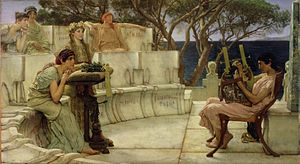
Sappho and Alcaeus,
Lawrence Alma-Tadema
, 1881
From the time of the European
Renaissance
, the interest in Sappho’s writing
has grown, seeing waves of fairly widespread popularity as new generations
rediscover her work. Since few people are able to understand ancient languages,
each age has translated Sappho in its own idiomatic way. Poetry, such as
Sappho’s, written in
quantitative verse
, is difficult to reproduce
in
English
which uses stress-based meters and
rhyme compared to Ancient Greek’s solely length-based meters. As a result, many
early translators used
rhyme
and worked Sappho’s ideas into English
poetic forms.
In the 1960s,
Mary Barnard
reintroduced Sappho to the reading
public with a new approach to translation that eschewed the use of rhyming
stanzas
and traditional forms. Subsequent
translators have tended to work in a similar manner. In 2002, classicist and
poet
Anne Carson
produced If Not, Winter, an
exhaustive translation of Sappho’s fragments. Her line-by-line translations,
complete with brackets where the ancient papyrus sources break off, are meant to
capture both the original’s lyricism and its present fragmentary nature.
Translations of Sappho have also been produced by
Willis Barnstone
,
Jim Powell
, and
Stanley Lombardo
.
|









